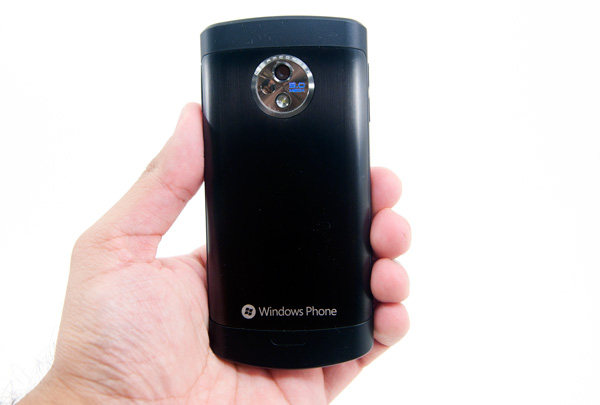LG's Optimus 7 & Samsung's Focus Reviewed: A Tale of Two Windows Phones
by Anand Lal Shimpi on December 3, 2010 10:14 PM EST- Posted in
- Smartphones
- Samsung
- Windows Phone 7
- LG Optimus
- LG
- Samsung Focus
- Mobile
Camera
Comparing smartphone cameras isn’t as easy as you’d think. You can take a bunch of shots in similar settings with different phones, but as with most things in this industry the manufacturers are all engaged in a high stakes game of tradeoffs. The obvious tradeoff up front is sensor quality vs. cost, once you make that tradeoff however there’s a lot more to worry about.
Much of how these cameras behave is up to software. There are certain things the iPhone’s camera does extremely well, and other things it just can’t ever seem to get right (e.g. white balance in certain types of CFL light). There’s also the debate of capturing reality vs. capturing what looks good. Oversaturating colors and employing TV-maker-style tricks come to mind here.
The Windows Phone 7 cameras we’ve played with have all been able to produce decent photos for web use. Given enough light and a very steady hand, you can even produce some sharp enough shots for small format prints.
I mention needing a steady hand because you are forced to use the physical shutter release button on the phone itself. The act of pushing down the button is often enough to blur a relatively slow rolling shutter.
Despite Microsoft mandating that all Windows Phone 7 devices have at least a 5MP camera, and supplying the default camera app, settings do vary between devices. For example, the HTC Surround allows you to set capture resolution but not compression level. The Focus and Optimus 7 let you do both.
The Optimus 7 adds a bunch of scene settings driven by LG’s own customizations, while the Focus has an option to enable “wide dynamic range”. The full breakdown of what you can do on these three phones is in the table below:
| Windows Phone 7 Camera App Settings Comparison | ||||
| HTC Surround | LG Optimus 7 | Samsung Focus | ||
| Scenes | Intelligent Shot | AF Mode | ||
| Effects | Beauty Shot | White Balance | ||
| Resolution | Panorama shot | Image Effect | ||
| Metering Mode | ScanSearch | Contrast | ||
| Flicker Adjustment | Photo Resolution | Saturation | ||
| Brightness | Sharpness | |||
| White Balance | EV | |||
| Color effect | ISO | |||
| Quality | Metering | |||
| Anti-shake | Photo Quality | |||
| Wide Dynamic Range | ||||
| Photo Resolution | ||||
| Anti-Shaking | ||||
It’s perplexing. Given how strict Microsoft has been elsewhere in the OS, even mandating what Start screen tiles OEMs/carriers are allowed to customize, this seems like a tremendous oversight. At the bare minimum all WP7 devices should have the same basic options to control things like JPEG quality and white balance.
The Focus has more normal camera settings while the Optimus 7’s settings are more geared towards scene control. The settings do tangibly change the image you get out of the camera in both cases.
Resolution options are also somewhat different between cameras. Although all three cameras have 5MP sensors the resolutions exposed vary among vendors:
| Windows Phone 7 Camera Resolution Settings Comparison | ||||
| HTC Surround | LG Optimus 7 | Samsung Focus | ||
| VGA (640 x 480) | 1M (1280 x 960) | VGA (640 x 480) | ||
| 1M (1280 x 960) | 3M (2048 x 1536) | 2M (1600 x 1200) | ||
| 2M (1600 x 1200) | 5M (2592 x 1944) | 3M (2048 x 1536) | ||
| 3M (2048 x 1536) | 16:9 1M (1280 x 720) | 5M (2560 x 1920) | ||
| 5M (2592 x 1944) | 16:9 2M (1920 x 1080) | |||
| 16:9 3.6M (2560 x 1440) | ||||
All three phones above feature a 4:3 5MP sensor. Only the Optimus 7 lets you shoot in a cropped 16:9 mode however. Samsung also crops its 5MP mode to 4,915,200 pixels, while the other two phones give you 5,038,848 pixels in their highest resolution mode. It’s not a big deal by any means, but curious nonetheless.
So how do these phones function as cameras? Both feature an LED flash, although the Optimus 7’s lens/flash cluster looks a bit fancier. As I mentioned before, I’d say both phones are easily capable of web quality photos; using the high resolution for detail in smaller photos vs. enabling huge images.
I’d argue that the Focus generally produces better looking images, at least more colorful, better exposed and marginally sharper ones.





























34 Comments
View All Comments
sprockkets - Saturday, December 4, 2010 - link
Or maybe you can comprehend that light that is picked up from an LCD in their measurements is the LCD trying to mask the BACKLIGHT and why they can never be as black as an OLED screen?popej_ - Saturday, December 4, 2010 - link
Do you know what is transflective LCD? That kind of screen can be perfectly visible in full sunlight without any backlight at all. You can get the same useless black measurement as for AMOLED :)strikeback03 - Monday, December 6, 2010 - link
My understanding was that transflective screens generally are worse on battery due to the need to power the backlight through the additional transflective layer. For a phone that was going to be used extensively outside it might be worth it, for a lot it wouldn't.Also I don't think most users are confusing reflections on a glossy screen with bad black levels.
banvetor - Saturday, December 4, 2010 - link
Hi Anand, thanks for the great review, as always. These 2 phones are exactly the ones I was setting my eyes on, and I feel I'm leaning towards Optimus 7 (since I live in Italy).Anyway, I posted this on Brian's HTC Surround review, but I figure I should ask the same to you also... could you give some details on the usability of each mobile OS when you DO NOT have a data plan?
I currently don't own a data plan, and actually don't plan on owning one... my main uses for my smartphone are music, taking photos, and some more occasional web browsing and e-mail checking when there is wi-fi or when I really need to (in which case I pay for the KB of data).
My main issue when switching from my current Nokia N96 to WP7 (I think I sit exactly with the people you mentioned on the first page, not really sold on Android and not wanting to jump into the Apple ecosystem) is how dependent this modern mobile OSes are on a always-on data connection. For instance, I'm guessing that Zune Pass will not be so useful to me, but maybe you can store some songs on the phone to listen to while offline... On Nokia even the maps are offline stored, but I guess this is too much to ask to these new OSes ;)
Anyway, it would be great if you could post some of your findings about this on your next reviews...
Many thanks!
Leo.
tipoo - Saturday, December 4, 2010 - link
I'm surprised that even the BB Torch and the Dell Streak running 1.6 beat these phones on the benchmark page, despite their faster hardware. Since this is a new product for Microsoft I won't rag on them for this, but it does look like some browser performance optimization is needed.JimmiG - Saturday, December 4, 2010 - link
The poor battery life of the Focus makes it very hard for me to recommend it to anyone. I know how frustrating it can be, since I have an HTC Desire, probably comparable to the Nexus One... Not being able to use the phone for what you want because you need to take a call in the afternoon and need to make sure there's some battery left, or having the phone die on you after 3/4ths of the commute home in the afternoon...that can be very annoying.. and the Focus is even worse. If I were buying a WP7 phone right now, I'd go with the LG for the battery life.Enrox - Saturday, December 4, 2010 - link
3 are the apps preinstalled but there are 7 more available in the dedicated LG app store in the markatplace.ltcommanderdata - Saturday, December 4, 2010 - link
I'm just curious whether your performance benchmarks for Apple's devices have been updated to use the latest iOS 4.2.1? I was interested in seeing if iOS 4.2.1 improves performance and/or battery life compared to iOS 4.1. iOS 4.1 used a Safari based on Safari 4's WebKit while iOS 4.2.1 comes with Safari 5 so it should offer much improved JavaScript performance. It would be useful if you included the iOS version number in brackets for your charts as you do for Android phones.VashHT - Saturday, December 4, 2010 - link
I was wondering what brightness levels you guys used for the browsing test. On the focus I found that the low brightness level was a lot brighter than low on the HD7 and very usable for daily use (unless you're in the sun). I'd be interested to see how the the brightness level affects the battery life of the focus.Esteban2 - Saturday, December 4, 2010 - link
Anand, nice job with review. I think it is one of the best I've seen and I've seen just about every one.I think you left out one important missing feature--Visual Voicemail. I was about to buy a Samsung Focus (who cares about cut and paste??) when I realized there was no Visual Voicemail. Honestly after almost 3 years with an iPhone I had forgotten about voicemail was like but this brought back the horrors very quickly. Another important missing feature--a favorites list. When you want to make a phone to someone you frequently call you don't want to go to contact list and all the mess of facebook postings, etc that you're forced to with WP7.
Anyway, I'm hanging on to my iPhone 3G for now and waiting to see when Microsoft updates and brings Visual voicemail. Honestly, I can't understand why this feature is missing it seems so basic but I actually like the OS so will keep watching and waiting for now. If not there in 6 months I may have to bite the bullet and go with iPhone 4.